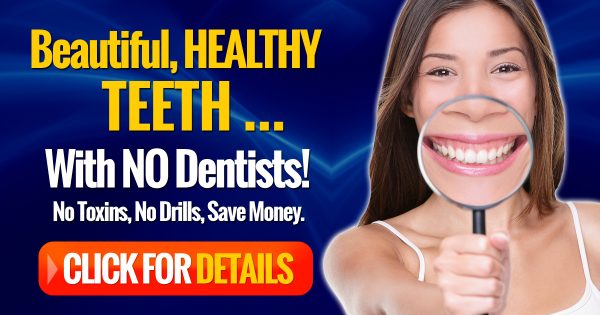Yes, you read that correctly—your teeth are alive.
Did you know that 92% of U.S. adults between the ages of 20 to 64 have the pleasure of experiencing a cavity in their permanent teeth. The “drill and fill” method is painful, expensive, and potentially toxic.
Check out this article about the Hidden Dangers of Commercial Dental Care!
It’s no wonder people are seeking alternatives to dentists.
You can repair cavities without a dentist and have squeaky clean teeth—just like coming out of the hygienists office—and not pay a cent?
Yup, its true.
The Adventure Began
A few years ago, I was on an adventure (and you know by now that I venture pretty far off the beaten path). I found this amazing healer who lives mostly out in the wilderness.
Doug had watched how the animals take care of their teeth, and he learned from primitive peoples (like the Tarahumara Indians), how they take care of their teeth.
So a few years ago, I got an abscessed tooth. And I healed it using Doug’s methods.
Amazing!
Doug is kinda different.
Uh, some folks have called him a tree hugger. He has that indigenous, earthy sort of vibe to him. But so many people from all walks of life have bought the video because the information is so good.
Now, let’s talk about your teeth being alive!
It might be difficult to believe that your teeth are alive because they are so hard, but it’s true. Nerves inside your teeth control blood flow and nourishment, so this makes your teeth another organ in your body.
Just like other organs in your body, it’s important to keep your teeth clean and healthy. If your teeth are unhealthy, it can affect the other organs, as well as your quality of life.
It’s not only about your smile!
There are two basic parts to your teeth: the crown and the root. Then, there is also the gum tissue and the bone, which are both very important.
Tooth Parts
The crown is what you see above the gumline.
The root is what is below the gumline. It is about 2/3rds the length of the entire tooth.
There are four different tissue types that make up each tooth.
Enamel is the white part of the tooth. It protects the tooth from wear and tear, and is very strong. It is also the hardest substance in your body.
Dentin supports the enamel. It’s a yellow bonelike material, slightly softer than enamel, that holds some of the nerve endings. These nerve endings let you know when there is something wrong with your teeth.
The Pulp is at the center of the tooth. It’s made up of soft tissue that contains blood vessels, lymph tissue, and nerves. Your teeth get nourishment and signals to and from your brain through the pulp.
Cementum covers the root of your tooth. It helps attach the tooth to the bones in your jaw.
The Periodontal Ligament is a cushioning layer that sits between the cementum and your jawbone. It helps connect the two.
Knowing your teeth is important, because if a tooth is alive, it can also die.
What is tooth decay?
You probably know tooth decay as cavities. Tooth decay happens when bacteria found in plaque coats your teeth and produces an acid, which erodes and destroys the tooth enamel. Once it destroys the tooth enamel, it begins to work toward the pulp.
This type of bacteria feeds on sugar and carbohydrates. If left untreated, this tooth erosion causes pain, infection, and eventually tooth death.
Poor oral hygiene, junk food, and acidic foods and drinks promote tooth decay, and the death of the tooth.
But there’s good news!
The hard tissue of your teeth can remineralize. But it’s not as easy as just taking a pill for it. You’ll need to maintain a diet that is good for your teeth and make sure that plaque and tartar are not left on your teeth.
7 things you can do to help remineralize your teeth
- Get off the sugar! This is what the plaque bacteria thrives on.
- Reduce your intake of grains, beans, lentils, soy, nuts, and seeds, but remember these are also important for a healthy balanced diet.
- Increase your vitamins and minerals, especially Vitamin A, C, and D, and Calcium, Magnesium, Zinc, and Iron.
- Eat apples, pears, raw celery and carrots, and cucumber to dilute sugars and stimulate saliva production, which will protect your teeth.
- Kill the cavity causing bacteria with good oral hygiene.
- Fix dry mouth! Saliva is very important in protecting your teeth from decay.
- Make your own toothpaste, mouthwash, and practice oil pulling.
Do you need an alternative for your dental care?
Discover …
- Dental hygiene without brushes, paste, or floss
- Healing cavities with herbs
- Treating abscesses with herbs and poultices
- Treating cracked and chipped teeth
(This article was originally published on August 10, 2017.)
Marjory Wildcraft is the founder of The Grow Network, which is a community of people focused on modern self-sufficient living. She has been featured by National Geographic as an expert in off-grid living, she hosted the Mother Earth News Online Homesteading Summit, and she is listed in Who’s Who in America for having inspired hundreds of thousands of backyard gardens. Marjory was the focus of an article that won Reuter’s Food Sustainability Media Award, and she recently authored The Grow System: The Essential Guide to Modern Self-Sufficient Living—From Growing Food to Making Medicine.









COMMENTS(14)
Yahoo keeps say the website is not available when I try to sign up. Is there a new site or address I should go to?
uh oh, let me check on that…
Interested in the info, but I also am unable to locate the website. Any updates?
Here is the link to the Alternatives To dentists info
I have not ordered the DVDs on dental health yet, but I did find the article by the herbalist Nicole Telkai. Very good article. However, people need to know that this plant is highly invasive and impossible to get rid of if it takes up residence in your garden. See the comments at “Dave’s Garden” by people who have dealt with it. http://davesgarden.com/guides/pf/go/58186/
I think my wife and I will raise it in a container and remove the spore heads so it does not spread by spores.
Marjory,
I read the following about teeth cleaning in a book written 125 years ago by Nellie Bly. I thought it was an interesting comment on the do-it-yourself dentistry that you sometimes feature on your website. I really enjoy the articles you post.
Ed A.
Eureka Springs, AR
Chapter 8 – Aden to Colombo
“Hiring a large boat, I went ashore with a half dozen acquaintances who felt they could risk the sun. The four oarsmen were black fellows, thin of limb, but possessed of much strength and tireless good humor. They have, as have all the inhabitants of Aden, the finest white teeth of any mortals. This may be due to the care they take of them and the manner of that care. From some place, I am unable to state where, as I failed to see one living thing growing at Aden, they get tree branches of a soft, fibrous wood which they cut into pieces three and four inches in length. With one end of this stick, scraped free of the bark, they rub and polish their teeth until they are perfect in their whiteness. The wood wears into a soft pulp, but as one can buy a dozen sticks for a penny one can well afford to throw the stick away after once using; although, if necessary, a stick can be used many times. I bought several sticks and found them the most efficient as well as pleasant tooth brush I had ever tried. I felt a regret that some enterprising firm had not thought of importing this useful bit of timber to replace the tooth-destroying brush used in America.”
Bly, Nellie. Around the World in Seventy-Two Days. Kindle Edition (Kindle Locations 5309-5316). Original edition published in 1890.
Ed, thank you so much for posting that! A friend of mine had traveled to Africa and told me a similar thing about ‘teeth sticks’ that the people still used today.
I’m a DC/NC x 25 years. Have found that rinsing and then spitting out DMSO relieves a toothache in minutes. DMSO will penetrate the tissue and get into the root bed of the tooth, can prevent need for root canal. DMSO heats up when mixed w/ water (or saliva), so be careful… I use full strength, but it can be diluted with water for a milder dose. Is safe to drink but I’m advising to spit it out after a few minutes. Good info source.
Drdavidwilliams/DMSO – Dr Z
hi can i get a specific information from you about the dmso? where you buy how to use for what it helps and how much time? thanks a lot!
What do you use to make your own toothpaste?
The best toothpaste is Revitin. It’s not really a toothpaste, but that’s what it’s called and you couldn’t make anything even close to how good it is for your oral health. But don’t use a harsh toothbrush.
Marjorie, we have a family story that you, and Doug, will relate to, verifying the ability of teeth to heal themselves. A brother, 13 years my junior, had the misfortune to smack his face into the upright window frame posts that autos of 40 odd years ago used to have. One of his two upper front center teeth, the absolute most visible ones, was split vertically into two pieces. The dentist immediately x-rayed. He literally burst into tears when he realized that he was looking at something dentists seldom if ever see, an x-ray of a set of perfect, cavity-free, adult teeth. Realizing that replacement could be done later, he put the two segments of the tooth together, somehow fastened them in place, to see what might happen. The two segments knit themselves back together. We lost the brother at the age of only 59 due to liver failure, but those perfect teeth were still intact.
I don’t trust the (what do you call it) coating/bonding they do with teeth. It’s my understanding that our teeth are supposed to be interacting with the environment in our mouths, and that if we block the bad stuff, we’re also blocking the good stuff (minerals and such) from them too.
What are ways to tell of your tooth is dead and can a dead tooth be revived?